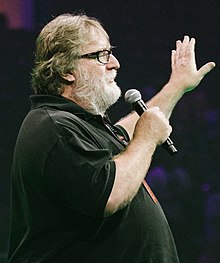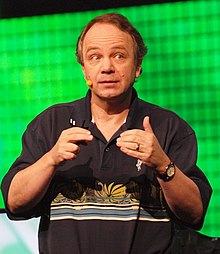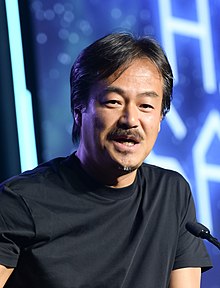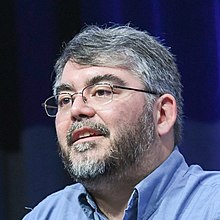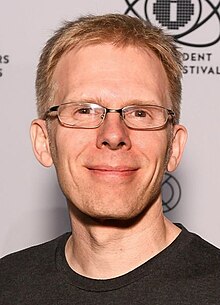Portal:Video games
The Video Games Portal

A video game or computer game is an electronic game that involves interaction with a user interface or input device (such as a joystick, controller, keyboard, or motion sensing device) to generate visual feedback from a display device, most commonly shown in a video format on a television set, computer monitor, flat-panel display or touchscreen on handheld devices, or a virtual reality headset. Most modern video games are audiovisual, with audio complement delivered through speakers or headphones, and sometimes also with other types of sensory feedback (e.g., haptic technology that provides tactile sensations). Some video games also allow microphone and webcam inputs for in-game chatting and livestreaming.
Video games are typically categorized according to their hardware platform, which traditionally includes arcade video games, console games, and computer (PC) games; the latter also encompasses LAN games, online games, and browser games. More recently, the video game industry has expanded onto mobile gaming through mobile devices (such as smartphones and tablet computers), virtual and augmented reality systems, and remote cloud gaming. Video games are also classified into a wide range of genres based on their style of gameplay and target audience. (Full article...)
Featured articles –
F-Zero GX is the successor to F-Zero X and continues the series' difficult, high-speed racing style, retaining the basic gameplay and control system from the Nintendo 64 game. A heavy emphasis is placed on track memorization and reflexes. GX introduces a "story mode" element, where the player assumes the role of F-Zero pilot Captain Falcon through nine chapters while completing various missions.
The GX and AX project was the first significant video game collaboration between Nintendo and Sega. GX was well received by critics for its visuals, intense action, high sense of speed, and track design while its high difficulty has been criticized. In the years since its release it has been considered one of the GameCube's best titles, as well as one of the greatest video games ever made. (Full article...)
Sega partnered with GE Aerospace to develop the Model 2, which renders 3D graphics capable of texture filtering and texture mapping. Daytona USA was developed by AM2 after a meeting of the heads of Sega's regional offices to decide on a game to debut the Model 2 hardware. The concept was suggested by Tom Petit, president of Sega's American arcade division, with input from AM2 director Toshihiro Nagoshi, who became the game's director and producer. Sega aimed to outperform Namco's Ridge Racer (1993). The developers researched motorsports extensively; they mapped Daytona International Speedway, and their experience developing Virtua Racing (1992) helped with lighting and camera control.
Daytona USA was a critical and commercial success, praised for its graphics, soundtrack and gameplay. A conversion was made for the Sega Saturn in 1995, and was followed by sequels and enhancements for consoles and arcades. It has been frequently named one of the best video games of all time. (Full article...)
Resident Evil 2 was produced by Resident Evil director Shinji Mikami, directed by Hideki Kamiya, and developed by a team of approximately 50 across 21 months. The initial version, commonly referred to as Resident Evil 1.5, differs drastically; it was canceled at approximately two thirds completion because Mikami decided it was inadequate. The final design introduced a more cinematic presentation.
Resident Evil 2 received acclaim for its atmosphere, setting, graphics, audio, scenarios, overall gameplay, and its improvements over the original game, but with some criticism towards its controls, voice acting, and certain gameplay elements. It is widely listed among the best video games ever made. It is the best-selling Resident Evil game for a single platform at more than 6 million copies sold across all platforms. It was ported to Windows, Nintendo 64, Dreamcast, and GameCube, and a modified 2.5D version was released for the Game.com handheld. The story of Resident Evil 2 was retold and built upon in several later games, and has been adapted into a variety of licensed works. It was followed by Resident Evil 3: Nemesis in 1999. A remake was released for PlayStation 4, Windows, and Xbox One in 2019. (Full article...)
Rare was a prominent second-party developer for Nintendo in the 1990s, and their Killer Instinct series was produced as an exclusive partnership in response to the popularity of Mortal Kombat. Following the success of the 1995 Killer Instinct port for the Super Nintendo Entertainment System, Rare began a sequel for the same platform but transitioned development to its successor, the Nintendo 64, upon its unveiling. Gold was scheduled as a launch title for the new console but was delayed until its North American release in November 1996. It was released in other regions in May 1997. Gold was later included in Rare's 2015 Xbox One retrospective compilation, Rare Replay.
Reviewers preferred the Nintendo 64 port over the arcade release, and appreciated its audiovisual enhancements, but felt that its graphical upgrades and memorization-based combo gameplay were insufficient when compared to fighting games like Tekken 2 and Virtua Fighter 2. Critics recommended Gold primarily for fans of the series and genre, but IGN reported that even fans were upset by changes in the combo system and the absence of several well-liked characters. Gold ultimately did not replicate the success of its Super NES predecessor, and the series remained dormant through its 2002 acquisition by Microsoft until its 2013 reboot. (Full article...)
Development of Final Fantasy XIII-2 began in early 2010 and lasted about one and a half years. The game was unveiled at the Square Enix 1st Production Department Premier in January 2011. Many of the key designers remained in their roles from the previous game, and developer tri-Ace was hired to help with the game's design, art, and programming. The development team wanted to exceed Final Fantasy XIII in every aspect while making the story's tone more dark and mysterious than the previous game. The game builds upon the Paradigm Shift battle system used in XIII and includes a less linear overall design.
Final Fantasy XIII-2 received critical acclaim in Japan and generally positive reviews from Western video game journalists. Though praised for its gameplay, lack of linearity, and graphics, the game's story was criticized as weak and confusing. The game was the fifth-best selling game of 2011 in Japan, and sold 3.1 million copies worldwide by January 2013. A sequel, Lightning Returns: Final Fantasy XIII, was released in 2013 in Japan and 2014 worldwide. (Full article...)
Did you know... -
- ... that Kainé from the video game series Nier was created in response to a female staff member's vague wish for a "male heroine"?
- ... that after becoming paralyzed from the neck down, Rocky "RockyNoHands" Stoutenburgh broke two Guinness World Records in the video game Fortnite?
- ... that the video game Manor Lords was wishlisted more than three million times on Steam after its developer had estimated it would receive around 14,000?
- ... that the video game Serious Sam: Tormental was originally inspired by Geometry Wars?
- ... that the 2014 text adventure The Uncle Who Works for Nintendo is inspired by a source cited by children for spreading video game rumors?
- ... that a version of the video game Rhino Rumble was not released due to the creators not wanting to add licensed characters?
- ... that Terra Invicta's development company is a group of former volunteer video game modders that decided to release their own game after the success of their mod?
- ... that Elena from the video game series Street Fighter uses a capoeira fighting style, for which the development team used travel videos as reference material as they had no experience with the style?
- ... that the case Lewis Galoob Toys, Inc. v. Nintendo of America, Inc. was considered essential to the future of video game modding in the United States in 1992?
- ... that the album series Jingle Cats spawned Jingle Dogs, Jingle Babies, and a Japanese video game in which "the object is to breed and care for cats, which begin to sing when they're done copulating"?
- ... that Justin Yu, the current Classic Tetris World Champion, is also a cellist in MIT's video game orchestra?
- ... that the 2005 video game Bokura no Kazoku was inspired in part by the birth of its creator's first child?
Selected biography –
Selected image -

- April 16, 2024 – 2023–2024 video game industry layoffs
- American video game company Take-Two Interactive lays off 5% of its workforce. (Reuters)
- April 10, 2024 – 2023–2024 video game industry layoffs
- American video game company Epic Games announces that it will lay-off around 870 employees, roughly one-sixth of its workforce, due to slower growth than expected. (CBC via Yahoo! News)
- December 22, 2023 –
- China passes a series of regulations aimed at limiting video game microtransactions. The new rules include banning rewards for logging on for multiple consecutive days and banning rewards for players if they spend money in a game for the first time. (Reuters)
Topics
Categories
Things you can do
In other Wikimedia projects
The following Wikimedia Foundation sister projects provide more on this subject:
-
Commons
Free media repository -
Wikibooks
Free textbooks and manuals -
Wikidata
Free knowledge base -
Wikinews
Free-content news -
Wikiquote
Collection of quotations -
Wikisource
Free-content library -
Wikiversity
Free learning tools -
Wiktionary
Dictionary and thesaurus









